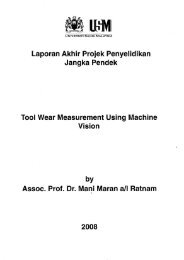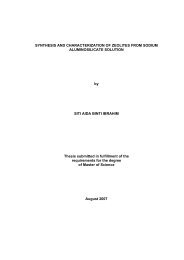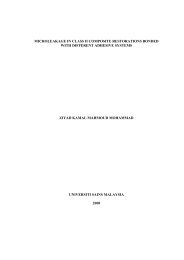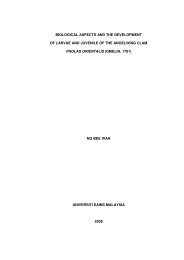[ED04] Process design of hydro-distillation in ginger oil ... - USM
[ED04] Process design of hydro-distillation in ginger oil ... - USM
[ED04] Process design of hydro-distillation in ginger oil ... - USM
You also want an ePaper? Increase the reach of your titles
YUMPU automatically turns print PDFs into web optimized ePapers that Google loves.
The 4th Annual Sem<strong>in</strong>ar <strong>of</strong> National Science Fellowship 2004<br />
[<strong>ED04</strong>] <strong>Process</strong> <strong>design</strong> <strong>of</strong> <strong>hydro</strong>-<strong>distillation</strong> <strong>in</strong> g<strong>in</strong>ger <strong>oil</strong> production<br />
Nurul Azl<strong>in</strong>a Mohamed, Noor Azian Morad, Mustafa Kamal Abd. Aziz<br />
Center <strong>of</strong> Lipids Eng<strong>in</strong>eer<strong>in</strong>g and Applied Research (C.L.E.A.R), Universiti Teknologi Malaysia,<br />
54100 Jalan Semarak, Kuala Lumpur, Malaysia<br />
Introduction<br />
Currently, there are a few conventional<br />
and modern methods <strong>of</strong> extract<strong>in</strong>g essential<br />
<strong>oil</strong>s such as by <strong>hydro</strong>-<strong>distillation</strong> (Purseglove<br />
et al., 1981), solvent extraction (Chrissie,<br />
1996), supercritical fluid extraction (Kelly et<br />
al., 2002) and microwave extraction (Soud et<br />
al, 2002). Hydro-<strong>distillation</strong> is the oldest and<br />
most common method <strong>of</strong> extract<strong>in</strong>g essential<br />
<strong>oil</strong> s<strong>in</strong>ce it is economically viable and safe.<br />
Although distill<strong>in</strong>g equipment has gradually<br />
improved through the years, the method for<br />
extract<strong>in</strong>g essential <strong>oil</strong> from the plant has<br />
changed very little especially <strong>in</strong> this region.<br />
Thus, the aim <strong>of</strong> this study was to study the<br />
operational conditions <strong>in</strong>volve <strong>in</strong> the<br />
extraction <strong>of</strong> g<strong>in</strong>ger <strong>oil</strong> based on the yield <strong>of</strong><br />
g<strong>in</strong>ger <strong>oil</strong> us<strong>in</strong>g the <strong>hydro</strong>- <strong>distillation</strong> process<br />
so that recommendations on the improvements<br />
on the present <strong>design</strong> used <strong>in</strong> Malaysia can be<br />
made.<br />
Materials and Methods<br />
The sample<br />
The g<strong>in</strong>ger used <strong>in</strong> this research was<br />
purchased at the Selayang Market, Selangor.<br />
As <strong>in</strong> most spices, the g<strong>in</strong>ger has to undergo a<br />
series <strong>of</strong> pre-treatment dur<strong>in</strong>g sample<br />
preparation to ensure maximum yield and<br />
quality <strong>of</strong> the oleores<strong>in</strong> and essential <strong>oil</strong> (Noor<br />
Azian et al., 2004). Two types <strong>of</strong> sample were<br />
used; sliced and ground g<strong>in</strong>ger.<br />
Extraction <strong>of</strong> g<strong>in</strong>ger <strong>oil</strong> by <strong>hydro</strong>-<strong>distillation</strong><br />
G<strong>in</strong>ger <strong>oil</strong> is extracted by <strong>hydro</strong><strong>distillation</strong>;<br />
water <strong>distillation</strong> and steam<br />
<strong>distillation</strong>. The g<strong>in</strong>ger <strong>oil</strong> extraction was done<br />
at atmospheric pressure and excess pressure.<br />
Steam <strong>distillation</strong> <strong>in</strong> this study was done by<br />
pack<strong>in</strong>g 1 cm <strong>of</strong> the 400 grams <strong>of</strong> fresh<br />
ground g<strong>in</strong>ger on a wire mesh above 7 litre <strong>of</strong><br />
distilled water and steamed <strong>in</strong> a closed still<br />
proper. However, steam was vented as to<br />
ensure atmospheric pressure throughout.<br />
Whereas, steam <strong>distillation</strong> at gauge pressures<br />
(0.3 bar, 0.6 bar, 0.9 bar and 1.2 bar) was<br />
carried out by not allow<strong>in</strong>g steam out <strong>of</strong> the<br />
vessel over the specified duration.<br />
The water <strong>distillation</strong> was carried out at<br />
atmospheric pressure. The procedures were<br />
quite the same as for the steam <strong>distillation</strong>.<br />
The only difference was that the sample was<br />
submerged <strong>in</strong> water rather than put on a tray.<br />
The effects <strong>of</strong> steam<strong>in</strong>g the dried g<strong>in</strong>ger<br />
samples prior to <strong>hydro</strong>-<strong>distillation</strong> at varied<br />
time and pressure were observed. The<br />
calculation for the yield <strong>of</strong> the g<strong>in</strong>ger <strong>oil</strong> is as<br />
follows:<br />
Yield (%) = Weight <strong>of</strong> g<strong>in</strong>ger <strong>oil</strong> collected (g) x 100%<br />
Initial weight <strong>of</strong> sample (g)<br />
Vapour Pressure Measurement<br />
The <strong>design</strong> <strong>of</strong> <strong>distillation</strong> equipment is<br />
based on vapour liquid equilibrium<br />
compositions. In this study, the VLE data was<br />
collected from experimental works. The VLE<br />
experiments were done under vacuum to<br />
determ<strong>in</strong>e the vapour pressure <strong>of</strong> the g<strong>in</strong>ger <strong>oil</strong><br />
and mixture <strong>of</strong> the g<strong>in</strong>ger <strong>oil</strong> and water. 60 ml<br />
<strong>of</strong> distil water is filled <strong>in</strong>to a glass-sampl<strong>in</strong>g<br />
flask (figure 1). The rotary pump and the<br />
diffusion pump are switched ON for about 45<br />
m<strong>in</strong>utes before the experiments can be carried<br />
out and the vacuum pump is to be switched<br />
ON throughout the experiment. Heat<strong>in</strong>g will<br />
start immediately after a steady pressure<br />
recorded by the gauge was achieved. The<br />
sample will be heated slowly for 1 0 C/m<strong>in</strong> and<br />
later 0.05 0 C/m<strong>in</strong> when approach<strong>in</strong>g the<br />
supposedly b<strong>oil</strong><strong>in</strong>g po<strong>in</strong>t. The b<strong>oil</strong><strong>in</strong>g<br />
temperature is determ<strong>in</strong>ed when the liquid<br />
temperature is the same as the vapour<br />
temperature at a constant pressure. The same<br />
experimental procedure and amount <strong>of</strong> sample<br />
was carried out for the determ<strong>in</strong>ation <strong>of</strong> the<br />
b<strong>oil</strong><strong>in</strong>g po<strong>in</strong>t <strong>of</strong> g<strong>in</strong>ger <strong>oil</strong>. For the vapour<br />
pressure measurement <strong>of</strong> the mixture <strong>of</strong> water<br />
and g<strong>in</strong>ger <strong>oil</strong>, the 60 ml <strong>of</strong> the mixture<br />
conta<strong>in</strong> 1 percent <strong>of</strong> g<strong>in</strong>ger <strong>oil</strong> and 99 percent<br />
water.<br />
527
The 4th Annual Sem<strong>in</strong>ar <strong>of</strong> National Science Fellowship 2004<br />
The same experimental procedure was also applied.<br />
Vacuum<br />
Cold trap<br />
Temperature<br />
display<br />
Cumulative Yield (%)<br />
0.30<br />
0.25<br />
0.20<br />
0.15<br />
0.10<br />
0.05<br />
0.00<br />
0 2 4 6 8<br />
Extraction time (hr)<br />
Sliced dried g<strong>in</strong>ger<br />
FIGURE 1 Vapour pressure measurement set up.<br />
Quality analysis<br />
The Refractometer is the fastest and<br />
reliable technique <strong>in</strong> quality control<br />
assessments and conformation <strong>in</strong> this study.<br />
The literature value for refractive <strong>in</strong>dex (RI)<br />
<strong>of</strong> g<strong>in</strong>ger <strong>oil</strong> is <strong>in</strong> the range <strong>of</strong> 1.4880 to<br />
1.4950. In this study, a Seiko heat flux DSC<br />
was also used as a method <strong>of</strong> determ<strong>in</strong><strong>in</strong>g the<br />
degradation temperature <strong>of</strong> the g<strong>in</strong>ger <strong>oil</strong>.<br />
Results and Discussions<br />
Effects <strong>of</strong> extraction time on yield<br />
Figure 2 shows the g<strong>in</strong>ger <strong>oil</strong> collected<br />
dur<strong>in</strong>g the 6 hours <strong>of</strong> water <strong>distillation</strong>. The<br />
graph shows that there was no g<strong>in</strong>ger <strong>oil</strong><br />
collected dur<strong>in</strong>g the first hour <strong>of</strong> extraction.<br />
This occurs s<strong>in</strong>ce the energy supplied <strong>in</strong>to the<br />
system, was used to heat the water and sample<br />
<strong>in</strong>side the b<strong>oil</strong>er. G<strong>in</strong>ger <strong>oil</strong> and water can<br />
only be seen condensed after the first hour <strong>of</strong><br />
extraction time. It was also observed that most<br />
<strong>of</strong> the g<strong>in</strong>ger <strong>oil</strong> distilled out dur<strong>in</strong>g the next 2<br />
hours. Prolong<strong>in</strong>g the extraction time will<br />
achieve a constant value <strong>of</strong> the g<strong>in</strong>ger <strong>oil</strong><br />
collected. Therefore, <strong>in</strong> order to have<br />
m<strong>in</strong>imum energy consumption, 4 hours <strong>of</strong><br />
extraction is enough to do the extraction.<br />
Effects <strong>of</strong> pressure on yield<br />
The effects <strong>of</strong> varied absolute pressure on<br />
the yield <strong>of</strong> the g<strong>in</strong>ger <strong>oil</strong> was carried out<br />
us<strong>in</strong>g sliced dried g<strong>in</strong>ger (Figure 3). From the<br />
figure, it can be concluded that higher<br />
pressure resulted <strong>in</strong> higher yield. In this case,<br />
extraction done at 2.2 bar gave an average <strong>oil</strong><br />
FIGURE 2 The cumulative g<strong>in</strong>ger <strong>oil</strong><br />
recovery over the extraction time at<br />
atmospheric pressure.<br />
yield <strong>of</strong> 0.34 percent. Nevertheless, the yield<br />
achieved through this extraction is considered<br />
to be low s<strong>in</strong>ce it is lower than the literature<br />
value. Results show that it is not practical to<br />
extract g<strong>in</strong>ger <strong>oil</strong> at excess pressure.<br />
Yield (%)<br />
0.40<br />
0.35<br />
0.30<br />
0.25<br />
0.20<br />
0.15<br />
0.10<br />
1.3 bar<br />
1.6 bar<br />
1.9 bar<br />
2.2 bar<br />
0 1 2 3 4<br />
No. <strong>of</strong> runs<br />
FIGURE 3 The yield <strong>of</strong> the g<strong>in</strong>ger <strong>oil</strong> collected by<br />
steam <strong>distillation</strong> at excess pressure for sliced<br />
g<strong>in</strong>ger.<br />
Figure 4 showed the results for yield <strong>of</strong><br />
g<strong>in</strong>ger <strong>oil</strong> extracted by water <strong>distillation</strong> and<br />
steam <strong>distillation</strong> <strong>of</strong> ground dried g<strong>in</strong>ger at<br />
atmospheric pressure. From this study, it<br />
seemed that water <strong>distillation</strong> <strong>of</strong> ground dried<br />
g<strong>in</strong>ger gave the highest recovery <strong>of</strong> the g<strong>in</strong>ger<br />
<strong>oil</strong> (1.53%) whilst the steam <strong>distillation</strong> gave<br />
only 1.42% <strong>of</strong> g<strong>in</strong>ger <strong>oil</strong>. Even though a<br />
higher g<strong>in</strong>ger <strong>oil</strong> recovery was achieved by<br />
528
The 4th Annual Sem<strong>in</strong>ar <strong>of</strong> National Science Fellowship 2004<br />
water <strong>distillation</strong>, this was not the only factor<br />
that determ<strong>in</strong>ed the ideal process. The RI <strong>of</strong><br />
the g<strong>in</strong>ger <strong>oil</strong> for both processes was also<br />
taken <strong>in</strong>to consideration. The RI <strong>of</strong> the g<strong>in</strong>ger<br />
<strong>oil</strong> for both processes (Figure 5) showed that<br />
g<strong>in</strong>ger <strong>oil</strong> extraction at excess pressure<br />
resulted <strong>in</strong> a very low values RI <strong>in</strong> the range<br />
<strong>of</strong> 1.4772 to 1.4775, which was far from the<br />
literature value <strong>of</strong> 1.4880 to 1.4950. This was<br />
possibly due to the overheat<strong>in</strong>g <strong>of</strong> the<br />
material, while wait<strong>in</strong>g for the vapours to be<br />
distilled out.<br />
Yield (%)<br />
1.60<br />
1.50<br />
1.40<br />
1.30<br />
1.20<br />
1.10<br />
1.00<br />
WD<br />
SD<br />
0 1 2 3 4<br />
Distillation Type<br />
FIGURE 4 Water <strong>distillation</strong> (WD) and steam<br />
<strong>distillation</strong> (SD) <strong>of</strong> ground dried g<strong>in</strong>ger at<br />
atmospheric pressure.<br />
Vapour Pressure Measurement <strong>of</strong> Pure<br />
Water, G<strong>in</strong>ger Oil and Mixture <strong>of</strong> G<strong>in</strong>ger Oil<br />
and Water Under Vacuum<br />
From the DSC study, it was illustrated<br />
that g<strong>in</strong>ger <strong>oil</strong> decomposed at 85.8 0 C at<br />
atmospheric pressure. This justified the need<br />
for the VLE experiments to be done under<br />
vacuum. From figure 6 it was observed that<br />
the b<strong>oil</strong><strong>in</strong>g po<strong>in</strong>t <strong>of</strong> g<strong>in</strong>ger <strong>oil</strong> is 141.0 0 C. The<br />
b<strong>oil</strong><strong>in</strong>g po<strong>in</strong>t <strong>of</strong> the mixture, the temperature<br />
at which the total vapour pressure equals 760<br />
mmHg is 97.5 0 C. From the same graph, the<br />
vapour pressure <strong>of</strong> water at this temperature<br />
can be estimated as 710 mmHg. Thus the<br />
vapour pressure <strong>of</strong> g<strong>in</strong>ger <strong>oil</strong> is (760-710<br />
mmHg) 50 mmHg. Results suggested that<br />
g<strong>in</strong>ger <strong>oil</strong> can be extracted under vacuum at a<br />
much reduced pressure.<br />
Refractive <strong>in</strong>dex (RI)<br />
FIGURE 5 The RI for the ground g<strong>in</strong>ger that<br />
underwent water <strong>distillation</strong> (WD) and steam<br />
<strong>distillation</strong> (SD) at atmospheric pressure and<br />
excess pressure.<br />
P (mmHg)<br />
1.4950<br />
1.4900<br />
1.4850<br />
1.4800<br />
1.4750<br />
800<br />
700<br />
600<br />
500<br />
400<br />
300<br />
200<br />
100<br />
0<br />
0 1 2 3 4<br />
No. <strong>of</strong> runs<br />
WD at atm P SD at atm P SD at excess P<br />
20 70 120 170<br />
T ( 0 C)<br />
G<strong>in</strong>ger <strong>oil</strong> + Water<br />
Experimental pure water<br />
G<strong>in</strong>ger <strong>oil</strong><br />
literature<br />
value<br />
FIGURE 6 Vapour pressure <strong>of</strong> pure water, g<strong>in</strong>ger<br />
<strong>oil</strong> and mixture <strong>of</strong> water and g<strong>in</strong>ger <strong>oil</strong>.<br />
Improve Design <strong>of</strong> the Steam Distillation<br />
Equipment<br />
The equipment required for carry<strong>in</strong>g on<br />
<strong>distillation</strong> <strong>of</strong> plant materials depends upon<br />
the size <strong>of</strong> the operation and the type <strong>of</strong><br />
<strong>distillation</strong> to be carried out. There are there<br />
ma<strong>in</strong> parts, which are (i) the retort or still<br />
proper, (ii) the condenser and (iii) the receiver<br />
for the condensate or <strong>oil</strong> separator.<br />
Improvements on the present <strong>design</strong> used <strong>in</strong><br />
Malaysia can be made based on the<br />
experimental data achieved <strong>in</strong> this study.<br />
529
The 4th Annual Sem<strong>in</strong>ar <strong>of</strong> National Science Fellowship 2004<br />
FIGURE 7 The improved steam <strong>distillation</strong><br />
equipment set up.<br />
The results from this study suggested that<br />
g<strong>in</strong>ger <strong>oil</strong> be extracted by steam <strong>distillation</strong>.<br />
The equipment must be made <strong>of</strong> sta<strong>in</strong>less steel<br />
s<strong>in</strong>ce g<strong>in</strong>ger <strong>oil</strong> consists <strong>of</strong> phenols, which<br />
will react with copper and any other metal<br />
(Figure 7). For larger and fixed <strong>in</strong>stallations,<br />
steam <strong>distillation</strong> is unquestionably <strong>of</strong>fers the<br />
most advantages. Among other advantages <strong>of</strong><br />
extract<strong>in</strong>g g<strong>in</strong>ger <strong>oil</strong> by steam <strong>distillation</strong> are<br />
as follows:<br />
(1) Without heat damage at ambient<br />
temperature throughout.<br />
(2) Without exposure to vacuum<br />
stripp<strong>in</strong>g.<br />
(3) Without loss <strong>of</strong> quality or fragile<br />
components.<br />
(4) Without be<strong>in</strong>g exposed to acidic gases<br />
or oxygen.<br />
(5) Without the need for alcohol<br />
ref<strong>in</strong>ement.<br />
(6) Simple to operate and easy to clean.<br />
(7) Non-hazardous, robust and simple to<br />
ma<strong>in</strong>ta<strong>in</strong>.<br />
(8) Low energy and labour cost.<br />
(9) Less costly than vacuum <strong>distillation</strong>.<br />
G<strong>in</strong>ger <strong>oil</strong> is a type <strong>of</strong> essential <strong>oil</strong> that is<br />
not suitable to be extracted at excess pressure<br />
s<strong>in</strong>ce g<strong>in</strong>ger <strong>oil</strong> decomposed at high<br />
temperature as illustrated by the quality<br />
analysis <strong>of</strong> g<strong>in</strong>ger <strong>oil</strong> <strong>in</strong> the previous<br />
discussion. Therefore, it is much more<br />
practical to be extracted at atmospheric<br />
pressure. In this case, wet steam is used to<br />
distil out the g<strong>in</strong>ger <strong>oil</strong>.<br />
M<strong>in</strong>or improvements were done on the<br />
<strong>design</strong> <strong>of</strong> the equipment currently used <strong>in</strong><br />
Malaysia. In this <strong>design</strong> as shown <strong>in</strong> figure 6,<br />
a heat<strong>in</strong>g c<strong>oil</strong> was used to b<strong>oil</strong> the water <strong>in</strong>side<br />
the vessel. This will allow sufficient heat<br />
supplied <strong>in</strong>to the system without burn<strong>in</strong>g the<br />
sample <strong>in</strong>side it. The height <strong>of</strong> the still<br />
depends on the porosity <strong>of</strong> the plant material.<br />
Plant material can be put on two trays at the<br />
same time as to allow more g<strong>in</strong>ger <strong>oil</strong><br />
recovered. A basket can also replace the trays.<br />
Another different feature <strong>in</strong> this <strong>design</strong> is that<br />
a sight glass was <strong>design</strong>ed on the left side <strong>of</strong><br />
the vessel as shown <strong>in</strong> figure 7 to make sure<br />
there was sufficient amount <strong>of</strong> water for<br />
<strong>distillation</strong> to happen. A gooseneck leads from<br />
the center <strong>of</strong> the spherical top cover to the<br />
condenser. The gooseneck is <strong>design</strong>ed not to<br />
be high, slightly curved and gradually<br />
descend<strong>in</strong>g as to avoid it from act<strong>in</strong>g as a<br />
reflux condenser. A baffle is put at the<br />
open<strong>in</strong>g to the gooseneck as to filter out<br />
particles that might also be evaporated <strong>in</strong> the<br />
process. As a precaution, a safety valve was<br />
also put <strong>in</strong>to the <strong>design</strong>. The still is also well<br />
<strong>in</strong>sulated to conserve heat. This is done to<br />
avoid excess condensation <strong>of</strong> steam with<strong>in</strong> the<br />
still as a result <strong>of</strong> heat losses from its surface.<br />
The bottom <strong>of</strong> the retort is also provided by a<br />
dra<strong>in</strong> valve sufficiently wide enough to<br />
dispense water <strong>in</strong>side the vessel. This dra<strong>in</strong><br />
valve also serves as an outlet for the wash<br />
water, when the still is cleaned.<br />
The condenser used <strong>in</strong> this <strong>design</strong> is a<br />
vertical c<strong>oil</strong> condenser as shown <strong>in</strong> figure 7<br />
that <strong>in</strong> which c<strong>oil</strong>s are <strong>in</strong>serted <strong>in</strong>to a tank<br />
supplied with runn<strong>in</strong>g cold water. The vertical<br />
condenser was chosen s<strong>in</strong>ce it will not take up<br />
a lot <strong>of</strong> space. Long c<strong>oil</strong>s were used so that<br />
less cool<strong>in</strong>g water is needed to make sure that<br />
the contact with the vapours and with the<br />
flow<strong>in</strong>g condensate lasts longer. This will also<br />
permit the absorption <strong>of</strong> more heat, so that at<br />
the end the temperature <strong>of</strong> the condensate will<br />
approach that <strong>of</strong> the <strong>in</strong>flow<strong>in</strong>g cool<strong>in</strong>g water.<br />
The third essential part <strong>of</strong> the equipment is<br />
the <strong>oil</strong> separator. Figure 7 shows the <strong>design</strong> <strong>of</strong><br />
the <strong>oil</strong> separator. The <strong>oil</strong> separator permits the<br />
removal <strong>of</strong> water whether the <strong>oil</strong> be<strong>in</strong>g<br />
distilled is heavier or lighter than water. S<strong>in</strong>ce<br />
the total volume <strong>of</strong> water condensed is always<br />
much more than the quantity <strong>of</strong> <strong>oil</strong>, the water<br />
will be removed cont<strong>in</strong>uously. The separator<br />
was also <strong>design</strong>ed so that water can be<br />
returned <strong>in</strong>to the still and redistilled dur<strong>in</strong>g<br />
<strong>distillation</strong> as shown <strong>in</strong> figure 7.<br />
530
The 4th Annual Sem<strong>in</strong>ar <strong>of</strong> National Science Fellowship 2004<br />
Acknowledgements<br />
The authors wished to thank the M<strong>in</strong>istry<br />
<strong>of</strong> Science, Technology and Innovation<br />
(MOSTI), Malaysia for the National Science<br />
Fellowship awarded to Nurul Azl<strong>in</strong>a<br />
Mohamed and for IRPA grant awarded to<br />
Assoc. Pr<strong>of</strong>. Dr. Noor Azian Morad. The<br />
authors also wish to thank <strong>in</strong>dividuals whom<br />
have contributed to this work.<br />
References<br />
Chrissie, W. (1996). “The Encyclopedia <strong>of</strong><br />
Aromatherapy.” Vermont: Heal<strong>in</strong>g Arts Press.<br />
Kelly, C. Z., Marcia, O. M. M., Ademir J.<br />
P and et. al. (2002). “Extraction <strong>of</strong> G<strong>in</strong>ger<br />
(Z<strong>in</strong>giber <strong>of</strong>fic<strong>in</strong>ale Roscoe) Oleores<strong>in</strong><br />
with CO2 and Co-solvent: A Study <strong>of</strong> the<br />
Antioxidant Action <strong>of</strong> the Extracts.”<br />
Supercritical Fluids 10: 11.<br />
Noor Azian Morad, Mustafa Kamal Abd Aziz<br />
and Nurul Azl<strong>in</strong>a Mohamed. (2004).<br />
“Changes <strong>of</strong> Cell Structure <strong>in</strong> G<strong>in</strong>ger Dur<strong>in</strong>g<br />
<strong>Process</strong><strong>in</strong>g.” Journal <strong>of</strong> Food Eng<strong>in</strong>eer<strong>in</strong>g 62:<br />
359-364.<br />
Purseglove, J. W., Brown, E. G., Green C.<br />
L. and Robb<strong>in</strong>s, S. R. J. (1981). “Spices.”<br />
London: Longman.<br />
Soud, A. A., Yunus, R. M., Aziz, R. A.<br />
(2002). “Malaysia.Exploration <strong>of</strong><br />
Essential Oil Extraction by us<strong>in</strong>g<br />
Microwave Technique.” The proceed<strong>in</strong>gs<br />
<strong>of</strong> RSCE and 16th SOMCHE: Malaysia.<br />
1369-1375.<br />
531


![[ED04] Process design of hydro-distillation in ginger oil ... - USM](https://img.yumpu.com/27762308/1/500x640/ed04-process-design-of-hydro-distillation-in-ginger-oil-usm.jpg)














